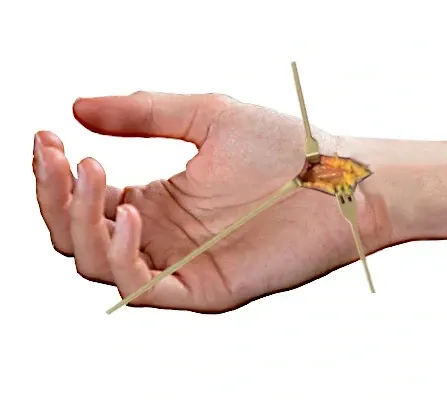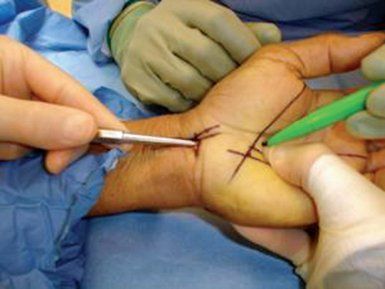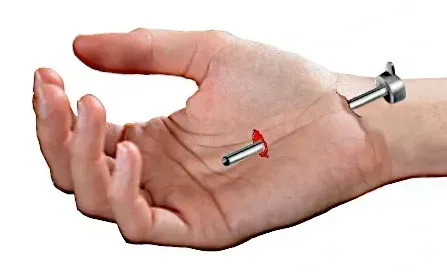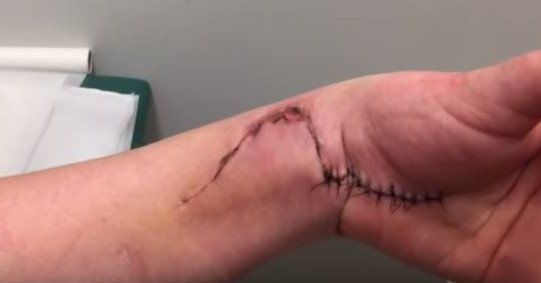Carpal Tunnel Endoscopic Surgery:
Pros & Cons
Table of Contents
- Which type carpal tunnel surgery will you have?
- Open carpal tunnel release surgery
- Single portal endoscopic carpal tunnel release surgery
- Double portal endoscopic carpal tunnel release surgery
- So which type of surgery is best?
- How carpal tunnel surgery is performed
- The basic goal of each surgical method
- Comparing open & endoscopic surgical techniques
- Endoscopic carpal tunnel surgery
- Open carpal tunnel surgery
- "Pros" of endoscopic carpal tunnel surgery (vs open surgery)
- Pro #1: Less trauma & pain
- Pro #2: Faster post-op recovery
- Pro #3: Less hand therapy & rehab
- Pro #4: Faster return to work
- Pro #5: Less scarring
- "Cons" of endoscopic carpal tunnel surgery (vs open surgery)
- Con #1: Higher cost
- Con#2: More risks & dangers
- Con #3: Fewer doctors do it
- Overall issues with carpal tunnel surgery
- What does surgical "success" mean?
- Good non-surgical alternatives
Next best thing to a cure - Summary
- FAQs
- About
Are you weighing the pros & cons of endoscopic surgery for carpal tunnel syndrome? Here you'll find an easy-to-understand discussion about carpal tunnel syndrome and all the advantages and disadvantages of this surgical procedure. In the end you'll be better equipped to make the smartest decision concerning your hand and your health.
Which type carpal tunnel surgery will you have?
Your doctor will recommend one of the three basic types of carpal tunnel surgery described below. (Note, some of these can be modified by the doctor.) The recommendation usually is based upon the surgeon's comfort and experience with one particular type of surgery.
Open carpal tunnel release surgery
Single portal endoscopic carpal tunnel release surgery
Double portal endoscopic carpal tunnel release surgery
So which type of surgery is best?
While this is the most-asked question by patients, sadly there isn't an easy answer. The best answer is, "It depends on the
doctor's preference and patient's needs."
The pros & cons of endoscopic surgery for carpal syndrome were hotly debated since the early 2000s. Even so, the relative ease and additional profitability of the endoscopic procedure (single or double portal method) is making it a winner in the minds of
doctors today. The
trend toward the endoscopic technique is fast overtaking the open technique in terms of popularity with doctors and patients. That's primarily driven by the relatively less pain and shorter aftercare and recovery times involved.
How carpal tunnel surgery is performed
The basic goal of each surgical method
You acquire carpal tunnel syndrome because your
flexor tendons inflame and swell inside your wrist joint. (Generally, overworking the fingers leads to the inflammation.) The swelling pushes on your
median nerve, ultimately crushing it. This causes all the main
carpal tunnel symptoms like
pain,
numbness, tingling,
shooting electric shocks, and weakness.
Rather than treating the inflammation, surgery merely "makes more room" inside the wrist joint. In other words, surgery "releases" the median nerve from being crushed by surrounding tendons. Cutting the ligament makes your wrist bones snap apart. This affords more room for the median nerve. More room means that the pressure on the nerve is relieved.
In order to release the nerve, all types of surgery require the surgeons to cut the
transverse carpal ligament. This thick tissue band holds your wrist bones together.
Comparing open & endoscopic surgical techniques
Endoscopic carpal tunnel surgery
Endoscopic carpal tunnel surgery starts with one or two small incisions in your wrist. In the
single portal technique the doctor inserts an endoscope and scalpel into the same incision. In the
double portal technique the doctor makes a second incision just for the scalpel. In either method, a fiberoptic camera on the end of the endoscope lets the doctor see the ligament before cutting it. After closing the holes with a couple stitches, you can go home after 1-2 hours.
Open carpal tunnel surgery
Open carpal tunnel surgery has a major difference compared to the
endoscopic technique. In the open technique, the doctor makes a 2-3 inch long incision in the palm. The objective is the same – to slice the transverse carpal ligament in half. The skin is closed with more stitches than the endoscopic method. After a 1-2 hour recovery time, you can go home.
"Pros" of endoscopic carpal tunnel surgery (vs open surgery)
Pro #1: Less trauma & pain
Considering all the pros and cons of endoscopic surgery for carpal tunnel,
the most significant advantage is the lesser trauma produced compared to the open release method.
Before single or double portal endoscopic surgery was developed, all doctors used the "open release" technique.
But the main problem is the open technique requires a 2-3 inch long cut on your palm. That means muscles and blood vessels are interrupted and even damaged.
As a result of the extensive tissue trauma with the open technique, there's much more
post-operative pain. This translates into more extensive aftercare and longer
recovery time after surgery (sometimes taking months). With the open technique, hand rehabilitation can take months or even a year.
In contrast, the endoscopic method (single or double portal) reduces these problems significantly. Recovery is faster, aftercare is easier, and rehabilitation time is shorter. Moreover, there's much less post-surgical pain.
When patients weigh all the pros and cons of endoscopic surgery for carpal tunnel surgery,
they consider having less pain as the major "pro".
Pro #2: Faster post-op recovery
As discussed above, the less extensive trauma resulting from endoscopic surgery means faster post-operative recovery. Patients usually see
stitches removed in a week. The surgical pain is almost gone within 2 weeks.
In contrast, with the open technique, postsurgical pain usually persist longer. Generally, it takes several weeks for pain to subside. Sometimes it can take months.
Pro #3: Less hand therapy & rehab
Just as the endoscopic method results in a faster post-operative recovery, your hand rehabilitation time happens faster as well. Less trauma means you retain more muscle strength. And your wrist can re-establish a normal range of motion faster.
Grip strength
is better immediately after the surgery. A shorter hand rehab time is one of the biggest factors when weighing the pros and cons of endoscopic surgery for carpal tunnel syndrome.
Pro #4: Faster return to work
Most (single or double portal) endoscopic surgery patients can return to work within a month. This compares to the open technique, which requires 2-3 months before returning to work. Either way, when you resume any work you must refrain from extensive hand and finger use. This is particularly the case if the surgery was on your dominant hand.
Your
job most likely caused carpal tunnel symptoms to erupt in the first place. Certain
harmful hand activities are known to correlate with getting carpal tunnel syndrome. Thus, going back to the same job is therefore not advised by doctors. In fact, only
10% of workers who had carpal tunnel surgery go back to their former job. The others had to find other employment or else another job function with the same employer.
Pro #5: Less scarring
The open technique results in a 2-3 inch long scar on your wrist. But with endoscopic surgery you may have one or two tiny scars instead. This isn't only a cosmetic advantage to endoscopic surgery. Scar
management
is important after surgery. The scar(s) left behind after the endoscopic technique require much less attention (see photos).
"Cons" of endoscopic carpal tunnel surgery (vs open surgery)
Con #1: Higher cost
The US national average cost for ALL carpal tunnel surgery is about
$7,000. Endoscopic carpal tunnel release surgery
(single or double portal)
costs about 44% more than open release surgery. Also, carpal tunnel surgery costs vary greatly from state to state.
(See your state's average cost here.)
The reason for the higher cost is the extra skill and training that goes into performing both types of endoscopic carpal tunnel release surgery. The instruments used are also more specialized and therefore more expensive.
However, the higher surgical cost of endoscopic surgery may be offset by lower rehabilitation costs. This surgery will likely require fewer physical therapy sessions. That translates into a lower cost overall.
Con#2: More risks & dangers
Most doctors describe both endoscopic techniques as a safer surgery, but it's not without risks. The most serious risk of (single or double portal) endoscopic carpal tunnel surgery is nerve injury. Why?
In the open technique, it's easy to expose and see the median nerve and its branches. But when using a camera in the endoscopic technique, the visibility isn't as good. As a result, there's a
1-2% chance the median nerve or its branch can be nicked by mistake. This could result in some loss of hand or finger function.
Another downside to endoscopic surgery is that symptoms may never resolve. However, the chances of that are equivalent to the open technique. So are the chances of recurring pain, excessive bleeding, and infection.
The slightly higher risk of nerve injury makes considering the pros and cons of endoscopic surgery for carpal tunnel more compelling.
Con #3: Fewer doctors do it
Only
20-25% of surgeons use the endoscopic technique (single or double portal) for carpal tunnel surgery. The reason is due to the more complex and extensive training required for this technique.
The open technique is straightforward and requires no special equipment. But the endoscopic techniques require
an expensive endoscope and other instruments. Also, there are special cutting tools from various medical device companies the surgeon can choose from (once he or she trains how to use them).
Overall issues with carpal tunnel surgery
What does surgical "success" mean?
You can weigh all the pros and cons of endoscopic surgery for carpal tunnel. But in the end it will be
your doctor's choice to use one of the endoscopic or open techniques on you. It depends on what he or she feels comfortable with.
That means you may have to shop around for a surgeon who performs the technique YOU desire.
More importantly, the pros and cons of endoscopic versus open release surgery must be weighed against "having surgery" in the first place. That's because the
overall "success rate" of carpal tunnel surgery is not fantastic.
Actually, your
doctor's definition of surgical success is whether or not the transverse carpal tunnel ligament was "severed without complications". That accounts for all the glowing statistics for the effectiveness of the operation.
But from the
patient's perspective it’s an entirely different story. Patients care about
satisfaction with their results. Most patients are fine for the first 6 to 12 months. But
about 56% of them complain symptoms return within two years. These patients are most definitely dissatisfied. And most end up back at square one again with pain and numbness.
Most of these patients
end up back where they began within 2 years of the surgery. Incredibly,
less than 5% of these patients go on to have a second (called "revision") surgery - which has an 80% failure rate.
Good non-surgical alternatives
Next best thing to a cure
Carpal tunnel syndrome is a permanent and incurable condition.
But its symptoms can be
reversed. (That's assuming you use the proper treatment.) It's not a "cure" but it's close.
In this respect, carpal tunnel is like type 2 diabetes. Type 2 diabetes can't be cured. But it can be naturally
reversed through diet and exercise.
Likewise, studies prove carpal tunnel can also be naturally reversed. The
specialized physical therapy technique called
myofascial release usually can eliminate carpal tunnel symptoms.
In short, whether you have diabetes or carpal tunnel, you can manage symptoms very well with therapy. But you’ll always be predisposed to symptoms returning because neither can be cured.
Experts are certain carpal tunnel can be brought on by repetitive strain injury due to overuse. Some scientists even call it "overuse injury". There are
particular hand stresses that are harmful - even dangerous - when performed routinely.
So, obviously, people who perform stressful activities with their hands tend to get carpal tunnel. But the problem is that many people get carpal tunnel but
never
overuse their hands. Why this happens is unknown, and something research is trying to answer.
Summary
Best of luck luck with weighing all the pros and cons of endoscopic surgery for carpal tunnel. And best of luck with whichever way you decide to take care of your hand's problems. The pros & cons of endoscopic surgery for carpal tunnel syndrome are many. You and your doctor should discuss the risks and benefits of having it. Whatever your decision, always keep in mind that surgery is not a "cure" for carpal tunnel syndrome. Surgery is only one type of treatment because carpal tunnel is a disease without a cure. Today, most doctors are opting for non-surgical treatments to relieve symptoms. These include night bracing, hand & finger exercises, and myofascial release massage. All work extremely well in most patients to manage this condition.
FAQs
Overall, it seems that endoscopic carpal tunnel release surgery is a better choice. Is that right?
The increasing number of this procedure each year suggests that most people find it the better choice for them.
What should I look for in a carpal tunnel surgery doctor?
Experience is the best marker of a good surgeon. Find one who has been practicing for decades.
Who decides on the type of operation; me or my doctor?
Your doctor will have more experience with one procedure type than another. If you are unhappy with the his/her choice, you should find another surgeon who has more experience using your preferred method.
About














